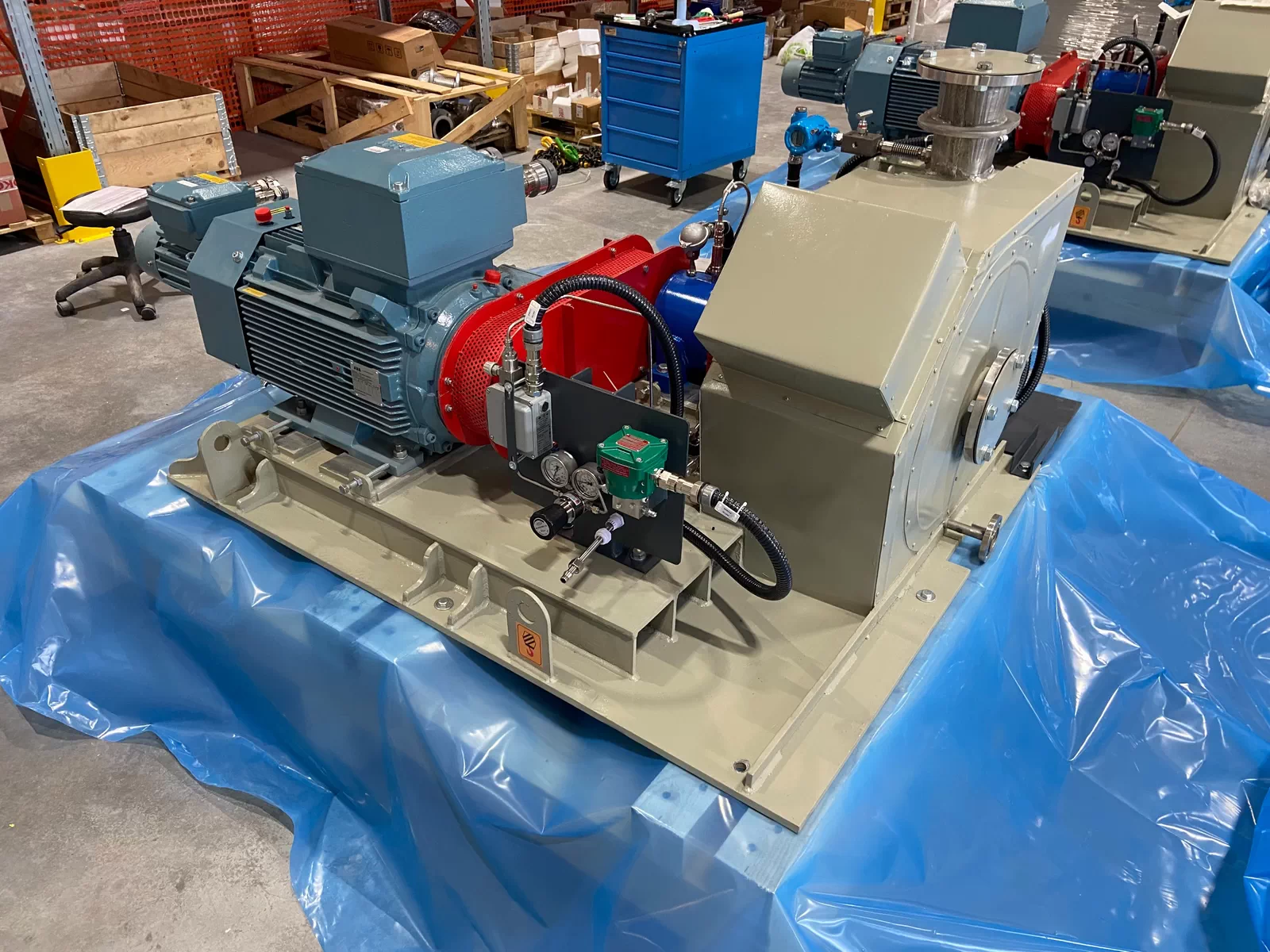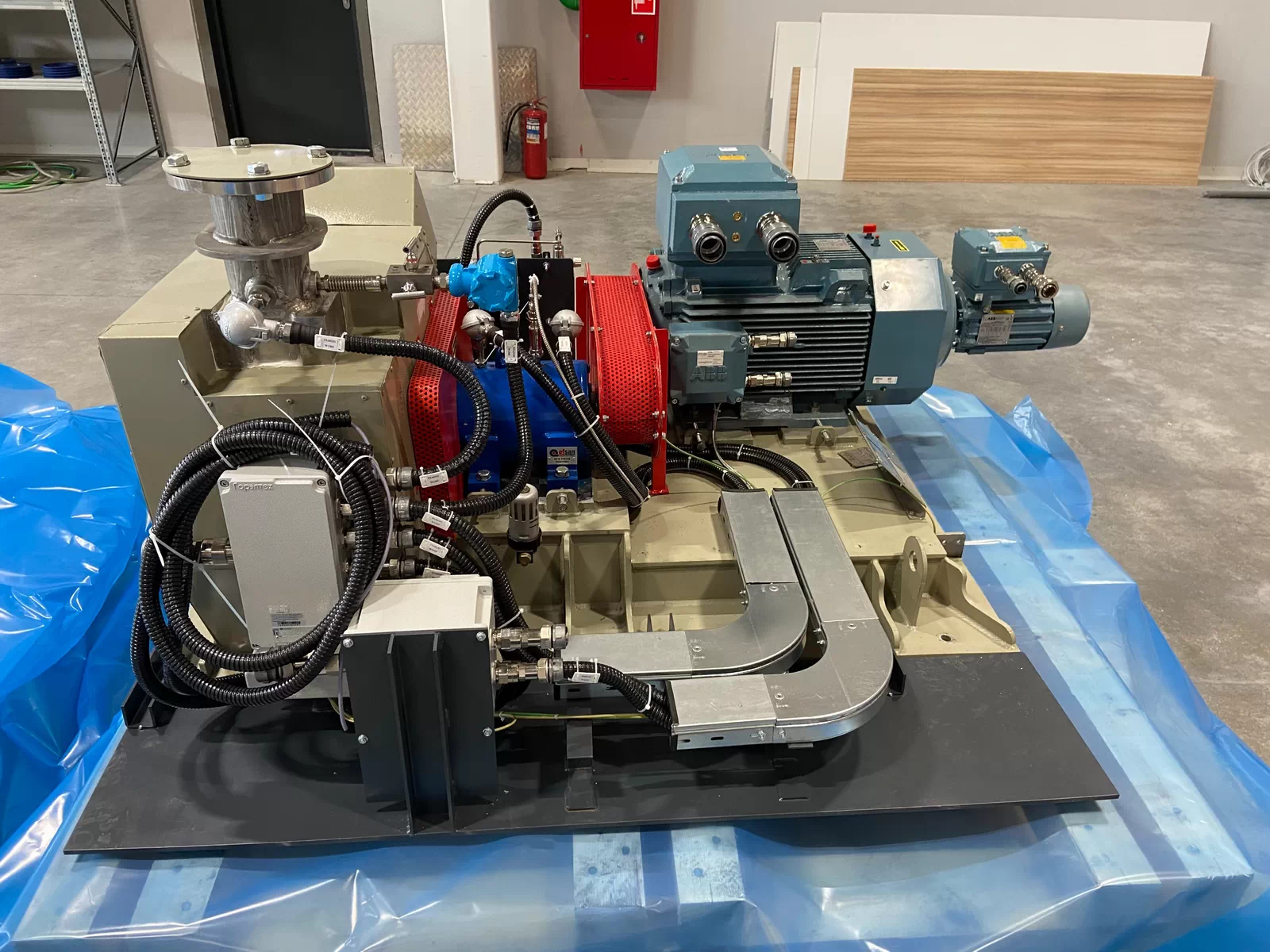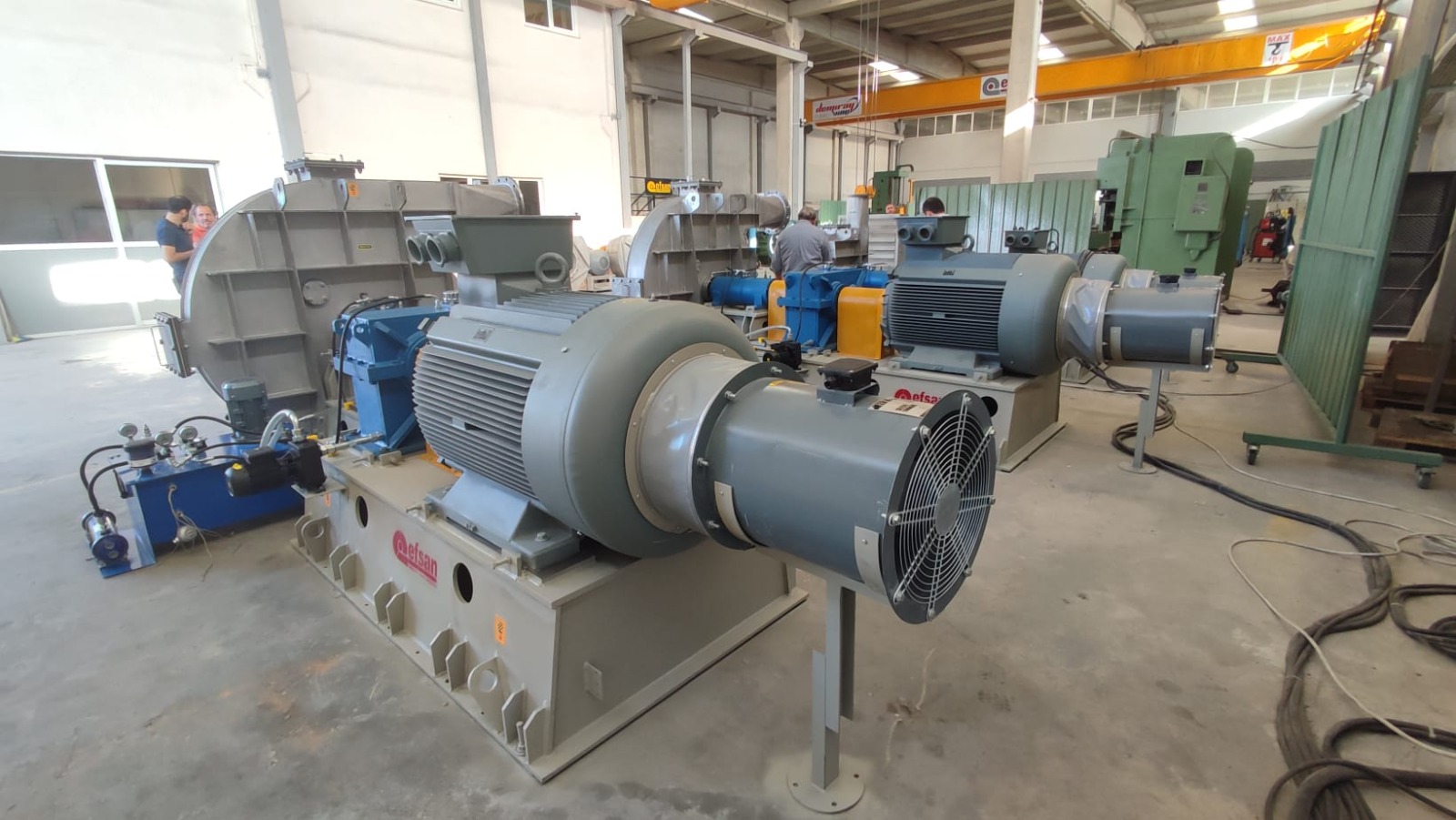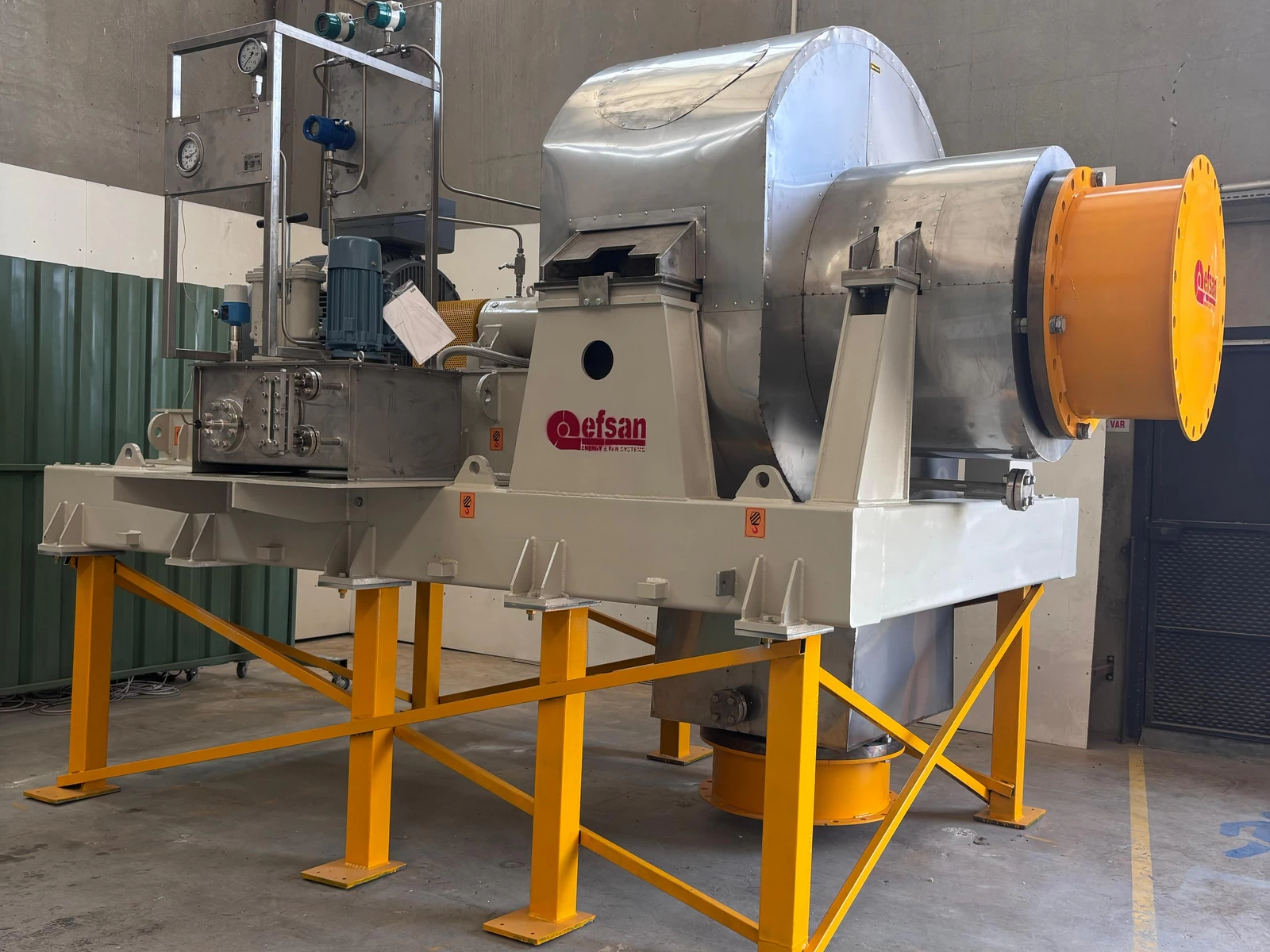Table of Contents
Cement plants are heavy industrial facilities characterized by high temperatures, intense dust, and continuous operation. One of the most critical pieces of equipment ensuring uninterrupted production under these demanding conditions is the primary air blower, also known as the high pressure blower.
Primary air fans are used in nearly all stages of cement production processes, including supplying combustion air to kilns, clinker cooling, dust collection, and pneumatic conveying. These fans not only enhance production efficiency but also help control energy consumption.
From an engineering perspective, high pressure blowers can reach a total pressure difference of up to 45 kPa in a single stage, while multi-stage blowers can reach up to 160 kPa. Thanks to these features, they reliably meet the high pressure and continuous air flow requirements of cement plants.
In this article, we will discuss the concept of “Primary Air Fan (High-Pressure Blower)” in technical detail; we will share its working principle, areas of use in cement factories, advantages it provides, and maintenance methods that should be considered for long-term use.

What is a Primary Air Fan (High-Pressure Blower)?
A primary air fan is a type of high-pressure industrial fan used in cement factories to feed combustion air to kilns and to provide the necessary air flow in coal and raw material grinding processes. The term “primary” comes from the fact that these fans provide the first and basic air source in the production process.
Generally manufactured in a radial (snail type) design, these fans convert air from low flow rates to high pressures. This provides the high-pressure and continuous air flow required in cement production processes.
According to industrial standards:
- High-pressure blowers are fans that generate pressures between 5 kPa and 25 kPa.
- In more specialized applications, single-stage models can reach up to 45 kPa.
- In multi-stage fans, pressure differences of up to 160 kPa can be achieved.
These values distinguish primary air fans from other fan types and make them indispensable, especially in heavy industrial facilities such as cement plants.
In addition, high-pressure blowers are made of special materials (carbon steel, stainless steel, heat-resistant coatings) to withstand the high temperatures (up to 280–430 °C) and heavy dust loads in the working environment.
How does it work?
The most basic task of primary air fans is to take air from a low pressure level, convert it to high pressure, and transfer it to production processes. A radial (snail type) design is generally used to perform this function.
As the fan impeller rotates, the air taken from the center accelerates in a circumferential direction due to the effect of the blades. The kinetic energy of the air is converted into pressure in the body structure. This provides the continuous and high-pressure air flow required by cement factories.
In modern industrial fans:
- Frequency inverters (VFD) can be used to control fan speed, thereby saving energy according to process requirements.
- Explosion-proof (Exproof) and TEFC motors are preferred to ensure safe operation in dusty and high-temperature cement factory environments.
- Automation systems allow continuous monitoring of fan performance and optimization of instantaneous pressure and flow values.
Thanks to this working principle, primary air fans provide not only ventilation but also critical benefits such as combustion efficiency, energy savings, and extended equipment life.
Areas of Use in Cement Factories
Cement production is a complex process involving high energy consumption and continuous processes. The primary air fans (high-pressure blowers) used in these processes perform critical tasks in almost every part of the plant. The main areas of use are as follows:
1. Furnace Combustion Air Supply
- High-pressure air is required to increase combustion efficiency in cement rotary kilns.
- Primary air fans improve combustion quality and energy efficiency by supplying the right amount of air at the right pressure to the kiln.
2. Clinker Cooling
- The clinker exiting the rotary kiln is at a temperature of approximately 1400 °C.
- High-pressure blowers ensure rapid and efficient cooling of the clinker, contributing to both energy recovery and material quality.
3. Raw Material and Coal Grinding
- A continuous air flow is required to refine the material in grinding mills.
- High-pressure blowers support this process, increasing grinding efficiency and ensuring the safe transport of coal dust.
4. Dust Collection and Filtration Systems
- Dust formation is inevitable in cement plants.
- Primary air fans provide the necessary air flow in bag filters and electrostatic precipitators, ensuring compliance with environmental standards.
5. Pneumatic Conveying Lines
- In cement production, ground raw materials and products are transported via pneumatic lines.
- High-pressure blowers are at the heart of these conveying systems, enabling the material to be transported continuously and safely.
Advantages of High-Pressure Blowers
Primary air fans used in cement plants not only provide air flow, but also offer many advantages in terms of production efficiency, energy savings, and safety. Although competing products often focus on technical specifications, the real value lies in the impact of these advantages on processes.
1. High Pressure Resistance
- The ability to create pressure differences of up to 45 kPa in single-stage fans and 160 kPa in multi-stage fans makes them indispensable for heavy industrial environments.
- This allows them to operate safely in long-distance pneumatic transport and high-temperature furnace processes.
2. High-Temperature Performance
- They are manufactured from special materials capable of withstanding temperatures up to 280–430 °C.
- This allows them to operate seamlessly in extreme high-temperature environments such as rotary kiln outlets and clinker cooling systems.
3. Energy Efficiency
- Models with speed control via a frequency inverter (VFD) reduce energy consumption according to process requirements.
- Automation integration prevents unnecessary energy losses.
4. Safety and Durability
- Explosion-proof (Exproof) and TEFC motors ensure safe operation in cement plants with high dust levels.
- Heavy-duty bearings and balanced impellers offer long-lasting use.
5. Contribution to Production Efficiency
- Increases combustion efficiency, reducing fuel consumption.
- Ensures effective performance in dust collection and filtration systems, facilitating compliance with environmental regulations.
- Provides uninterrupted flow in pneumatic conveying systems, guaranteeing production continuity.

Considerations for Fan Selection
The correct selection of the primary air fan to be used in cement plants directly affects both process efficiency and energy costs. An incorrectly selected fan can lead to serious problems such as excessive energy consumption, early failure, or process inefficiency.
The main criteria to consider when selecting a fan:
1. Pressure and Flow Rate Requirements
- The air flow rate (m³/h) and pressure (Pa) values required for different sections of the factory must be calculated in advance.
- For example, higher pressure is required for furnace combustion air, while a more balanced flow rate is important for dust collection systems.
2. Operating Environment Conditions
- Cement factories are environments with high temperatures and high dust concentrations.
- Therefore, the fan body, impeller, and motor must be heat resistant and protected against abrasive dust.
3. Material Selection
- Carbon steel: Provides sufficient durability for standard applications.
- Stainless steel: Longer service life against high temperatures and chemical effects.
- Coated surfaces: Provide protection against dust and abrasive particles.
4. Motor Type and Safety
- TEFC (Totally Enclosed Fan Cooled) motors prevent dust from entering.
- Explosion-proof (Exproof) motors guarantee safe operation in environments with explosion risk.
- These motor types should be preferred especially in cement factories.
5. Energy Efficiency and Control Systems
- Frequency inverter (VFD) fans provide significant energy savings by adjusting speed as needed.
- Automation integration enables real-time control of pressure and flow.
6. Compliance with Standards and Certifications
- Fans must comply with ATEX, ISO, and local safety standards.
- This is critical for both plant safety and long-term operating costs.
Periodic Maintenance and Fault Prevention
High-pressure blowers operating in heavy industrial plants such as cement factories require regular maintenance due to high temperatures, heavy dust, and continuous operating conditions. Without proper maintenance, energy consumption increases and production downtime may occur due to sudden failures.
1. Bearing and Impeller Checks
- Fan bearings should be lubricated at regular intervals and checked for signs of wear.
- Impellers should be checked for imbalance and dynamically balanced if necessary.
2. Vibration and Noise Monitoring
- Vibration analysis is one of the most effective methods for early detection of fan failures.
- Abnormal vibration values may indicate bearing failure, impeller damage, or alignment problems.
- Sudden changes in noise levels should also be considered as a sign of failure.
3. Dust and Filter Cleaning
- Due to the high dust load in cement plants, regular cleaning or replacement of filters is essential.
- Dust accumulated on the fan housing and blades can lead to efficiency loss and unstable operation.
4. Motor and Electrical Checks
- Motor insulation resistance should be measured, and loose cable connections should be tightened.
- Error codes and performance parameters in VFD (frequency inverter) systems should be reviewed periodically.
5. Periodic Maintenance Program
- Daily Checks: Monitoring noise, vibration, and temperature values.
- Monthly Checks: Bearing lubrication, filter cleaning, motor connection checks.
- Annual Maintenance: Dynamic balancing, bearing replacement, motor insulation test, detailed inspection of the housing and impeller.
This approach helps prevent unexpected failures, extends fan life, and maintains energy efficiency. As emphasized in Erciyes University’s academic study, regular monitoring of vibration data plays a critical role in predicting fan failures in advance.
New Generation High-Pressure Blower Technologies
Industrial blower technologies have undergone significant development in recent years, focusing on energy efficiency, safety, and automation. In energy-intensive facilities such as cement plants, these innovations are critical for both reducing costs and increasing operational safety.
1. Energy-Efficient Impeller Designs
- New-generation high-pressure blowers use aerodynamic blade structures to achieve lower energy consumption at the same pressure.
- These designs offer energy savings of 10–15% in clinker cooling and pneumatic conveying lines in particular.
2. Acoustic Optimization for Quiet Operation
- Advanced impeller geometries and special housing designs reduce noise levels.
- As a result, fans comply with occupational safety standards and create a more comfortable working environment for operators.
3. Automation and IoT Integration
- Modern fan systems are now equipped with sensor-based monitoring.
- The fan’s performance can be continuously monitored thanks to pressure, temperature, vibration, and energy consumption sensors.
- With IoT integration, this data is transferred to a cloud system, enabling predictive maintenance.
4. Materials Specially Designed for High Temperatures and Dusty Environments
- Housings that can withstand temperatures up to 300 °C and special coatings (ceramic, stainless steel) that are resistant to heat and abrasive dust are becoming more common.
- ATEX-certified designs ensure safe operation in potentially explosive environments.
These developments mean that primary air fans used in cement plants are no longer just “air-producing machines,” but have become smart, energy-efficient, and long-lasting systems.
Frequently Asked Questions (FAQ)
Are primary air fans and high-pressure blowers the same thing?
Yes. Primary air fans are a special type of high-pressure industrial fan used in cement plants. The term “primary” comes from the fact that they provide the first and most important air flow required for kiln combustion and the production process.
Why are primer air fans necessary in cement plants?
In cement production, continuous and high-pressure air flow is required in critical stages such as kiln combustion air, clinker cooling, grinding, dust collection, and pneumatic transport. Without a primer air fan, production efficiency cannot be achieved and the risk of plant downtime increases.
What is the service life of high-pressure blowers?
A correctly selected and regularly maintained high-pressure blower can operate trouble-free for 10–15 years. However, this period varies depending on the operating conditions of the plant, the dust density, and the regularity of maintenance intervals.
Which type of fans should be preferred for energy savings?
VFD (frequency inverter) high-pressure blowers significantly reduce energy consumption as they can adjust their speed according to process requirements. In addition, the same pressure values are achieved with lower energy consumption thanks to the new generation aerodynamic impeller designs.
How often should maintenance be performed on primary air fans?
- Daily: Noise, vibration, and temperature control.
- Monthly: Bearing lubrication, filter cleaning.
- Annual: Dynamic balancing, bearing replacement, motor insulation test.
Regular maintenance prevents breakdowns and extends fan life.
| Fan Type | Application | Pressure Range (Pa) | Operating Temperature (°C) | Note |
|---|---|---|---|---|
| ID Fan (Induced Draft) | Rotary kiln exhaust | 7,000 – 10,000 (7–10 kPa) | 280 – 430 | Requires high-temperature resistant materials |
| FD Fan (Forced Draft) | Combustion air supply | 5,000 – 7,000 | 200 – 300 | Improves combustion efficiency |
| Primary Air Fan | Grinding & combustion | 10,000 – 25,000 | 150 – 250 | Provides continuous high-pressure air |
| Clinker Cooling Fan | Clinker outlet | 6,000 – 8,000 | 150 – 200 | Contributes to energy recovery |
| Dust Collection Fan | Bag/filter systems | 3,000 – 6,000 | 100 – 150 | Essential for environmental compliance |
| Interval | Check / Task | Description |
|---|---|---|
| Daily | Noise and vibration measurement | Sudden increase indicates potential failure |
| Weekly | Filter and housing cleaning | Dust accumulation reduces efficiency |
| Monthly | Bearing lubrication & belt check | Check for wear and loosening |
| 6 Months | Impeller balancing and alignment | Perform dynamic balancing if necessary |
| Annually | Bearing replacement, motor insulation test | Critical maintenance for long service life |
| Every 2–3 Years | Detailed inspection of casing and impeller | Check for wear and corrosion |
| Technology | Benefit | Contribution in Cement Plants |
|---|---|---|
| VFD (Variable Frequency Drive) | 15–30% energy saving through speed control | Adapts pressure according to process needs |
| Aerodynamic Impeller Design | Lower energy consumption | Improves grinding and pneumatic conveying efficiency |
| IoT & Sensor-Based Monitoring | Predictive maintenance | Detects failures in advance, reduces downtime |
| Exproof / TEFC Motors | Safe operation in dusty environments | Ensures safety in explosive-prone areas |
Conclusion and Call
In heavy industrial plants such as cement factories, primary air fans (high-pressure blowers) play a vital role in terms of production efficiency and energy management.
From kiln combustion air to clinker cooling, from pneumatic conveying lines to dust collection systems, the high-pressure air flow provided by these fans at every stage enables production to continue uninterrupted and safely.
A properly selected fan not only enhances process efficiency but also offers benefits such as energy savings, compliance with environmental standards, and long-term reliability. At this stage, determining the appropriate pressure and flow rates, selecting the right material and motor type suited to operating conditions, and implementing regular maintenance programs are critical.
At Efsan.com, we offer the most efficient and reliable solutions for cement factories with our years of engineering experience in high-pressure blower systems.
If you want to find the right primary air blower solution for your factory, reduce your energy costs, and increase your process efficiency, contact us today.
tags :
More about the sector and our business




